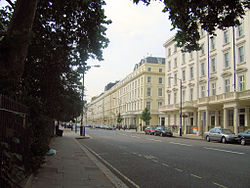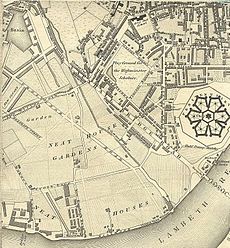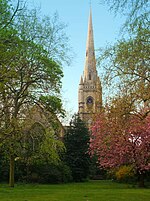Pimlico: Difference between revisions
Created page with ':''For other places see Pimlico (disambiguation)'' {{Infobox town |name=Pimlico |county=Middlesex |picture=Belgrave.jpg |picture caption=Belgrave Road from St George's Squar…' |
No edit summary |
||
| Line 1: | Line 1: | ||
{{Hatnote|For other places see [[Pimlico (disambiguation)]]}} | |||
{{Infobox town | {{Infobox town | ||
|name=Pimlico | |name=Pimlico | ||
Revision as of 08:48, 29 July 2014
| Pimlico | |
| Middlesex | |
|---|---|
 Belgrave Road from St George's Square | |
| Location | |
| Grid reference: | TQ295785 |
| Location: | 51°29’19"N, 0°8’22"W |
| Data | |
| Post town: | London |
| Postcode: | SW1V |
| Dialling code: | 020 |
| Local Government | |
| Council: | Westminster |
| Parliamentary constituency: |
Cities of London and Westminster |
Pimlico is a small area of central London in Middlesex. Like Belgravia, to which it was built as a southern extension, Pimlico is known for its grand garden squares and impressive Regency architecture.
The area is separated from Belgravia to the north by Victoria Railway Station, and bounded by the River Thames to the south, Vauxhall Bridge Road to the east and the former Grosvenor Canal to the west.
At Pimlico's heart is a highly disciplined grid of residential streets laid down by the planner Thomas Cubitt beginning in 1825 and now protected as the Pimlico Conservation Area. Pimlico is also home to the pre-Second World War Dolphin Square development and the pioneering Churchill Gardens and Lillington Gardens estates, now designated conservation areas in their own right. The area has over 350 Grade II listed buildings and several Grade II* listed churches.
Notable residents have included politician Winston Churchill, designer Laura Ashley, philosopher Swami Vivekananda, actor Laurence Olivier, illustrator and author Aubrey Beardsley, Kenyan nationalist Jomo Kenyatta and Major Walter Wingfield, the inventor of lawn tennis.
History
Early history and origin of name
In the sixteenth and seventeenth centuries, the Manor of Ebury was divided up and leased by the Crown to servants or favourites. In 1623, James I sold the freehold of Ebury for £1,151 and 15 shillings. The land was sold on several more times, until it came into the hands of heiress Mary Davies in 1666.

Mary Davies's dowry not only included "The Five Fields" of modern-day Pimlico and Belgravia, but also most of what is now Mayfair and Knightsbridge. Understandably, she was much pursued by suitors. In 1677, at the age of twelve, she married Sir Thomas Grosvenor. The Grosvenors were a family who had been of consequence in the Middle Ages, and had their seat at Eaton Hall in Cheshire. Until this marriage though the Grosvenors were of little importance outside Cheshire, but Sir Thomas Grosvenor, by the development and good management of his wife's inheritance, acquired enormous wealth which has been retained by his descendant, the Duke of Westminster.
At some point in the late seventeenth or early eighteenth century, the area ceased to be known as Ebury or "The Five Fields" and gained the name by which it is now known. While its origins are disputed, it is "clearly of foreign derivation...." according to some authorities. Gifford, in a note in his edition of Ben Jonson, tells us that 'Pimlico is sometimes spoken of as a person, and may not improbably have been the master of a house once famous for ale of a particular description."[1] Supporting this etymology, Rev. Brewer describes the area as "a district of public gardens much frequented on holidays. According to tradition, it received its name from Ben Pimlico, famous for his nut-brown ale. His tea-gardens, however, were near Hoxton, and the road to them was termed Pimlico Path, so that what is now called Pimlico was so named from the popularity of the Hoxton resort".[2]
Development and decline
By the nineteenth century, and as a result of an increase in demand for property in the previously West End of London following the Great Plague of London and the Great Fire of London, Pimlico had become ripe for development. In 1825, Thomas Cubitt was contracted by Lord Grosvenor to develop Pimlico. The land up to this time had been marshy but was reclaimed using soil excavated during the construction of St Katherine's Dock.[3]
Cubitt developed Pimlico as a grid of handsome white stucco terraces. The largest and most opulent houses were built along St George's Drive and Belgrave Road, the two principal streets, and Eccleston, Warwick and St George's Squares. Lupus Street contained similarly grand houses, as well as shops and, until the early twentieth century, a hospital for women and children.[4] Smaller-scale propertes, typically of three storeys, line the side streets. An 1877 newspaper article described Pimlico as "genteel, sacred to professional men… not rich enough to luxuriate in Belgravia proper, but rich enough to live in private houses." Its inhabitants were "more lively than in Kensington… and yet a cut above Chelsea, which is only commercial."[5]
Although the area was dominated by the well-to-do middle and upper-middle classes as late as Booth's 1889 Map of London Poverty,[6] parts of Pimlico are said to have declined significantly by the 1890s. When Rev Gerald Olivier moved to the neighbourhood in 1912 with his family, including the young Laurence Olivier, to minister to the parishioners of St Saviour, it was part of a venture to west London "slums" that had previously taken the family to the depths of Notting Hill.
Through the late nineteenth century, Pimlico saw the construction of several Peabody Estates, charitable housing projects designed to provide affordable, quality homes.
Twentieth Century resurgence
Proximity to the Houses of Parliament made Pimlico a centre of political activity. Prior to 1928, the Labour Party and Trades Union Congress shared offices on Eccleston Square, and it was here in 1926 that the general strike was organised.
In the mid 1930s Pimlico saw a second wave of development with the construction of Dolphin Square, a self-contained "city" of 1,250 upmarket flats built on the site formerly occupied by Cubitt's building works. Completed in 1937, it quickly became popular with MPs and public servants. It was home to fascist Oswald Mosley until his detention in 1940, and the headquarters of the Free French for much of the Second World War.
Pimlico survived the war with its essential character intact, although parts sustained significant bomb damage. Through the 1950s these areas were the focus of large-scale redevelopment as the Churchill Gardens and Lillington Gardens estates, and many of the larger Victorian houses were converted to hotels and other uses.
In order to provide affordable and efficient heating to the residents of the new post-war developments, Pimlico became one of the few places in the UK to have a district heating system installed. District heating became popular after Second World War to heat the large residential estates that replaced areas devastated by the Blitz. The Pimlico District Heating Undertaking (PDHU) is just north of the River Thames. The PDHU first became operational in 1950 and continues to expand to this day. The PDHU once relied on waste heat from the now-disused Battersea Power Station on the South side of the River Thames. It is still in operation, the water now being heated locally by a new energy centre which incorporates 3.1 MWe /4.0 MWTh of gas-fired CHP engines and 3 x 8 MW gas-fired boilers.
In 1953, the Second Duke of Westminster sold the part of the Grosvenor estate on which Pimlico is built.[7]
Pimlico was connected to the underground in 1972 as a late addition to the Victoria Line. Following the designation of a conservation area in 1968 (extended in 1973 and again in 1990), the area has seen extensive regeneration. Successive waves of development have given Pimlico an interesting social mix, combining exclusive restaurants and residences with council-run facilities.
Churches
The area contains a number of attractive Church of England churches, most constructed at the time the neighbourhood was laid down. Churches include:
- Church of England:
- St Gabriel's, Warwick Square
- St Saviour
- St James the Less
- Roman Catholic: Holy Apostles (destroyed in the Blitz and rebuilt in 1957)
Notable buildings

Dolphin Square is a block of private apartments built between 1935 and 1937. At the time of their construction the development was billed as the largest self-contained block of flats in Europe. It is home to many Members of Parliament.
Churchill Gardens is a large housing estate covering the south-west corner of Pimlico. It was developed between 1946 and 1962 to a design by the architects Powell and Moya, replacing docks, industrial works, and several Cubitt terraces damaged in the Blitz.
On Buckingham Palace Road is the former "Empire Terminal" of Imperial Airways, a striking Art Moderne building designed in 1938 by architect Albert Lakeman.[8] Mail, freight and passengers were transported from the terminal to Southampton by rail before transferring to flying boats. The building now serves as the headquarters of the National Audit Office.
The Tate Britain is located within the ward of Millbank, but is a short walk from Pimlico underground station and is regarded as a Pimlico landmark. The district's association with fine art has been reinforced by the Chelsea College of Art and Design's recent move to the former Royal Army Medical College next to the Tate.
Pimlico School, a comprehensive school built between 1967 and 1970, was a notable example of Brutalist architecture. It was demolished in 2010.
Pimlico in literature and popular culture
On film:
- Gaslight filmed in 190 has Pimlico as its setting.
- Passport To Pimlico, is an Ealing Comedy made immediately after the Second World War, in which Pimlico finds that it is an independent "Duchy of Burgundy".
In books:
- G K Chesterton's book Orthodoxy uses Pimlico is used as an example of "a desperate thing." Arguing that things are not loved because they are great but become great because they are loved, he asserts that if merely approved of, Pimlico "will remain Pimlico, which would be awful," but if "loved with a transcendental tie and without any earthly reason" it "in a year or two might be fairer than Florence."
- Excellent Women by Barbara Pym has a St Mary's Church, inspired by St Gabriel's Church in Pimlico
House of Cards, Michael Dobbs's 1989 novel, has Francis Urquhart's home in Pimlico
- Corduroy Mansions by Alexander McCall Smith is set in Pimlico.
Transport

- Pimlico is served by Pimlico station on the Victoria Line of London Underground and Victoria station on the Victoria, District and Circle Lines. It is also served by National Rail services to London Victoria Station.
- Riverboat services to Waterloo and Southwark run from Millbank Millennium Pier.
The area has a dozen docking stations for the Barclays Cycle Hire scheme.
Pimlico would be connected at Victoria to the proposed Chelsea-Hackney line (Crossrail 2). Plans under consideration for the redevelopment of Nine Elms and Battersea Power Station include a pedestrian bridge stretching across the river from St. George's Square.[9]
Outside links
| ("Wikimedia Commons" has material about Pimlico) |
References
- ↑ 'Pimlico', Old and New London - Volume 5 (1878), pp. 39-49.
- ↑ Rev. E. Cobham Brewer, Brewer's Dictionary of Phrase and Fable, 1898 edn.
- ↑ I never knew that about London: Christopher Winn
- ↑ The Fascination of London: Mayfair, Belgravia and Bayswater, 1903
- ↑ Pimlico design guide
- ↑ Map of London Poverty
- ↑ The Grosvenor Estate
- ↑ http://taylorempireairways.com/2009/11/imperial-airways-building-sw1/
- ↑ [http://www.london.gov.uk/archive/mayor/planning/oapf-nine-elms/docs/oapf-nine-elms-framework-draft-nov-09-main.pdf Mayor of London – Nine Elms Framework
Books
- Secret London by Andrew Duncan (New Holland Publishers, London, 2001)
- The Face of London by Harold P Clunn (Spring Books, London, 1970)
